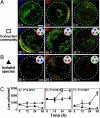Defined spatial structure stabilizes a synthetic multispecies bacterial community
- PMID: 19011107
- PMCID: PMC2587551
- DOI: 10.1073/pnas.0807935105
Defined spatial structure stabilizes a synthetic multispecies bacterial community
Abstract
This paper shows that for microbial communities, "fences make good neighbors." Communities of soil microorganisms perform critical functions: controlling climate, enhancing crop production, and remediation of environmental contamination. Microbial communities in the oral cavity and the gut are of high biomedical interest. Understanding and harnessing the function of these communities is difficult: artificial microbial communities in the laboratory become unstable because of "winner-takes-all" competition among species. We constructed a community of three different species of wild-type soil bacteria with syntrophic interactions using a microfluidic device to control spatial structure and chemical communication. We found that defined microscale spatial structure is both necessary and sufficient for the stable coexistence of interacting bacterial species in the synthetic community. A mathematical model describes how spatial structure can balance the competition and positive interactions within the community, even when the rates of production and consumption of nutrients by species are mismatched, by exploiting nonlinearities of these processes. These findings provide experimental and modeling evidence for a class of communities that require microscale spatial structure for stability, and these results predict that controlling spatial structure may enable harnessing the function of natural and synthetic multispecies communities in the laboratory.
Conflict of interest statement
The authors declare no conflict of interest.
Figures




Comment in
-
Building communities one bacterium at a time.Proc Natl Acad Sci U S A. 2008 Nov 25;105(47):18075-6. doi: 10.1073/pnas.0810201106. Epub 2008 Nov 19. Proc Natl Acad Sci U S A. 2008. PMID: 19020083 Free PMC article. No abstract available.
References
-
- Dechesne A, Or D, Smets BF. Limited diffusive fluxes of substrate facilitate coexistence of two competing bacterial strains. FEMS Microbiol Ecol. 2008;64:1–8. - PubMed
-
- Kaeberlein T, Lewis K, Epstein SS. Isolating “uncultivable” microorganisms in pure culture in a simulated natural environment. Science. 2002;296:1127–1129. - PubMed
-
- Ohno M, et al. Establishing the independent culture of a strictly symbiotic bacterium Symbiobacterium thermophilum from its supporting Bacillus strain. Biosci Biotechnol Biochem. 1999;63:1083–1090. - PubMed
Publication types
MeSH terms
Substances
Grants and funding
LinkOut - more resources
Full Text Sources
Other Literature Sources
Molecular Biology Databases

